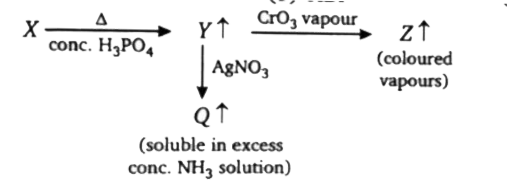CO2−3 anion has which of the following characterstics
Bonds of unequal length
sp3 hybridization of C atom
Resonance stabilization
Different bond angles
The correct Answer is:C
To analyze the characteristics of the carbonate anion CO2−3, we can follow these steps:
Step 1: Understand the Structure of Carbonate Ion
The carbonate ion consists of one carbon atom bonded to three oxygen atoms. The overall charge of the ion is -2.
Step 2: Draw the Lewis Structure
To draw the Lewis structure of CO2−3:
- Carbon (C) is the central atom.
- Oxygen (O) atoms are surrounding the carbon atom.
- There are two negative charges distributed among the oxygen atoms.
The Lewis structure can be represented as:
- One double bond between carbon and one oxygen atom, and two single bonds between carbon and the other two oxygen atoms, each carrying a negative charge.
Step 3: Identify Resonance Structures
The carbonate ion exhibits resonance. This means that the double bond can shift between the three oxygen atoms. The resonance structures can be depicted as:
1. O=C(O−)O−
2. O−C(O=O−)
3. O−O−C=O
Step 4: Analyze Bond Lengths
Due to resonance, all C-O bonds in the carbonate ion are of equal length. This is a key characteristic of resonance structures, where the actual bond order is an average of the contributing structures.
Step 5: Determine Hybridization of Carbon
To find the hybridization of the carbon atom in CO2−3:
- Carbon has 4 valence electrons.
- There are three oxygen atoms bonded to carbon (considering the charge).
- Using the formula for hybridization:
Hybridization=12(V+M+C)
where V is the number of valence electrons, M is the number of monovalent atoms (0 in this case), and C is the charge (+2 for anions).
- Thus, Hybridization=12(4+0+2)=3, which indicates sp2 hybridization.
Step 6: Analyze Bond Angles
The geometry of the carbonate ion is trigonal planar due to sp2 hybridization, leading to bond angles of approximately 120 degrees.
Conclusion
From the analysis:
- The carbonate ion does not have bonds of unequal length (all are equal).
- The carbon atom is sp2 hybridized, not sp3.
- It exhibits resonance stabilization.
- The bond angles are equal (120 degrees), not different.
Thus, the only characteristic that the carbonate ion CO2−3 possesses is resonance stabilization.
The carbonate ion consists of one carbon atom bonded to three oxygen atoms. The overall charge of the ion is -2.
To draw the Lewis structure of CO2−3:
- Carbon (C) is the central atom.
- Oxygen (O) atoms are surrounding the carbon atom.
- There are two negative charges distributed among the oxygen atoms.
- One double bond between carbon and one oxygen atom, and two single bonds between carbon and the other two oxygen atoms, each carrying a negative charge.
The carbonate ion exhibits resonance. This means that the double bond can shift between the three oxygen atoms. The resonance structures can be depicted as:
1. O=C(O−)O−
2. O−C(O=O−)
3. O−O−C=O
Due to resonance, all C-O bonds in the carbonate ion are of equal length. This is a key characteristic of resonance structures, where the actual bond order is an average of the contributing structures.
To find the hybridization of the carbon atom in CO2−3:
- Carbon has 4 valence electrons.
- There are three oxygen atoms bonded to carbon (considering the charge).
- Using the formula for hybridization:
Hybridization=12(V+M+C)
where V is the number of valence electrons, M is the number of monovalent atoms (0 in this case), and C is the charge (+2 for anions).
- Thus, Hybridization=12(4+0+2)=3, which indicates sp2 hybridization.
The geometry of the carbonate ion is trigonal planar due to sp2 hybridization, leading to bond angles of approximately 120 degrees.
From the analysis:
- The carbonate ion does not have bonds of unequal length (all are equal).
- The carbon atom is sp2 hybridized, not sp3.
- It exhibits resonance stabilization.
- The bond angles are equal (120 degrees), not different.
Topper's Solved these Questions
- CHEMICAL BONDING & MOLECULAR STRUCTURE BOOK - VMC MODULES ENGLISHCHAPTER - CHEMICAL BONDING & MOLECULAR STRUCTURE EXERCISE - IN-CHAPTER EXERCISE-J
10 Videos
- CHEMICAL BONDING & MOLECULAR STRUCTURE BOOK - VMC MODULES ENGLISHCHAPTER - CHEMICAL BONDING & MOLECULAR STRUCTURE EXERCISE - IN-CHAPTER EXERCISE-K
6 Videos
- CHEMICAL BONDING & MOLECULAR STRUCTURE BOOK - VMC MODULES ENGLISHCHAPTER - CHEMICAL BONDING & MOLECULAR STRUCTURE EXERCISE - IN-CHAPTER EXERCISE-H
10 Videos
- CHEMICAL BONDING & CHEMICAL STRUCTURE BOOK - VMC MODULES ENGLISHCHAPTER - CHEMICAL BONDING & CHEMICAL STRUCTURE EXERCISE - IMPECCABLE
50 Videos
- CHEMICAL BONDING-I & IIBOOK - VMC MODULES ENGLISHCHAPTER - CHEMICAL BONDING-I & IIEXERCISE - JEE Advanced (Archive)
98 Videos
Similar Questions
Knowledge Check
Which of the following anions is most stabilised?
A B
B C
C DAll have same stability
DAll have same stabilityWhich of the following anions is resonance destabilized?
A B
B C
C D
D

Which of the following anion cannot be in X?
View SolutionWhich of the following anion has the smallest radius?
View SolutionWhich of the following anion has the smallest radius?
View SolutionResistance to jassids in cotton and cereal leaf beetles in wheat is due to which of the following morphological characterstics ?
View SolutionWhich of the following anions is the weakest base ?
View SolutionWhich of the following oxy anion is metaborate ion ?
View Solution